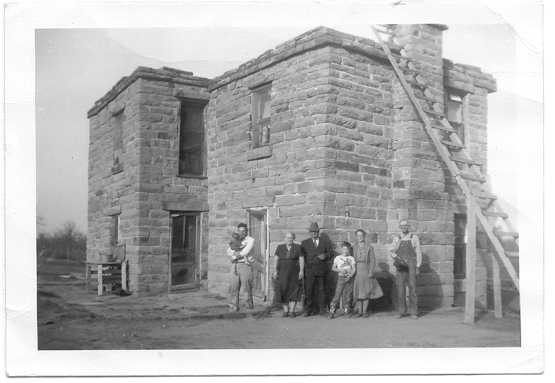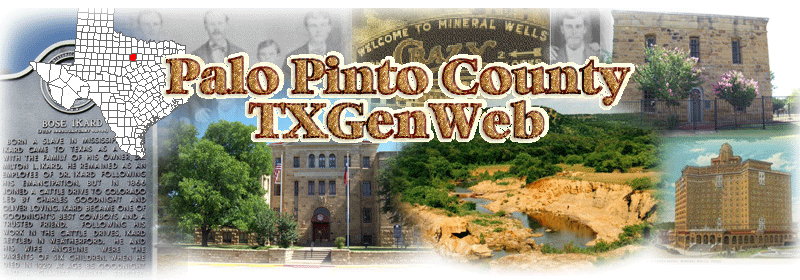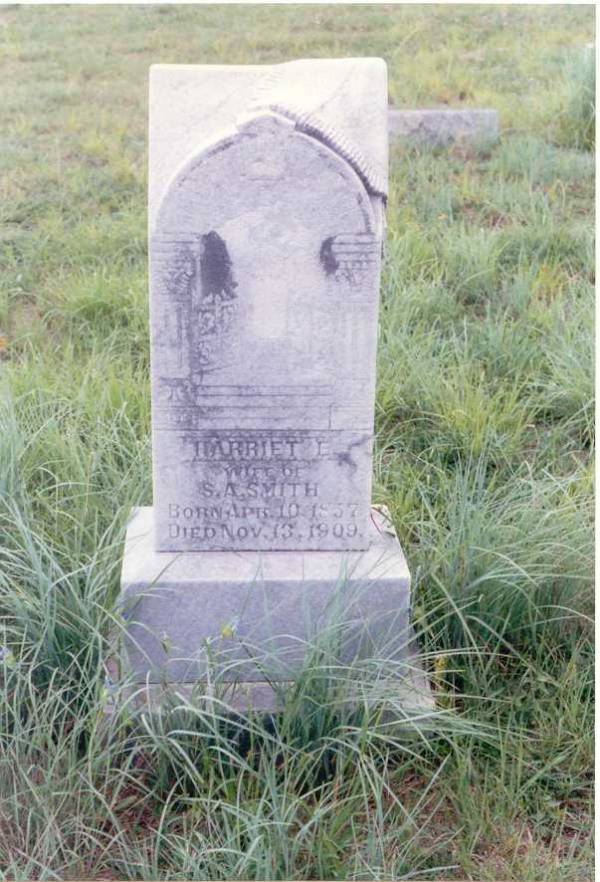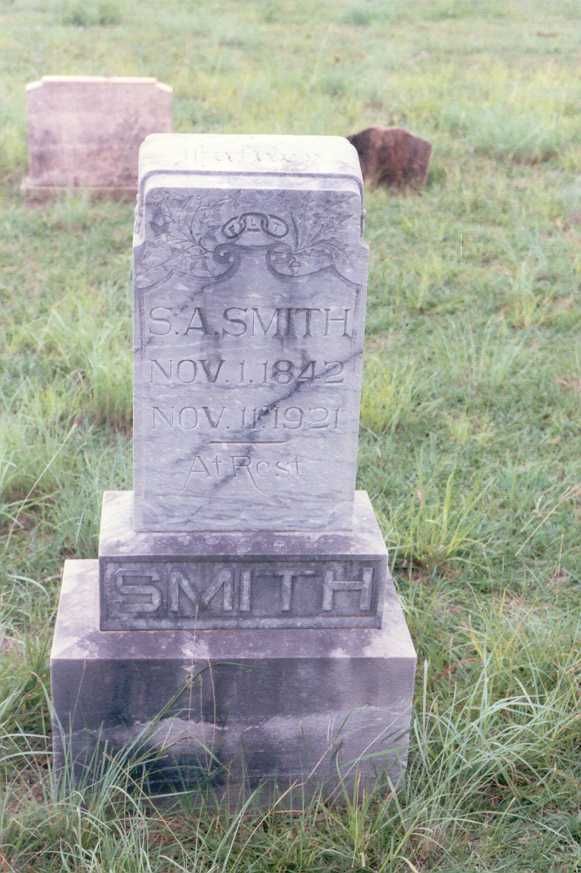|
2nd Article about Smith Family
S.
A. Smith Family
Moves to Palo Pinto
The Sandstone Home of S. A. Smith Near Santo
submitted by
Carole Vaught

The picture shows the family of Thelma Smith Cox a granddaughter of S. A. Smith
Article in the "Palo Pinto County Star" Thursday April
2, 1981 by Larry Wright
Picture of the stone house with caption which reads; SANDSTONE HOME of S. A. Smith near Santo built at the top of Buck Creek mountain by Smith and his sons of hand hewn sandstone found on the premises. The front entrance was near the fireplace. The house was occupied from the early 1900's until 1963. Rock house near Santo has colorful history
"You never know what you can do until you try," Mrs. S. A. Smith used to say to her granddaughter Mrs. Bessie Bosley of Santo. "Or maybe I was too young to realize the danger until we were well along the trail. But then I was a very determined young woman." She would smile ruefully as she recalled the day in mid-summer of the late 1880s' when she kissed her husband goodbye and loaded their nine children in the wagon and headed the Four young mules toward their new home in Texas. Mr. Smith remained in Denver, Colorado, to earn the money to supply their needs for the trip and to help found their new home at Santo.
'Trip fever' ran high among the youngsters, but it was pure relief to Mrs. Smith to be on the trail at last. It had been a busy year. Nearly 18 months really had gone into preparation for the trip. Clothes had to be made...food canned and put up .. the huge wagon had to be made and supplied.
Smith, a professional buggy and carriage maker, made the wagon himself in the shop where he worked in Denver. It had to be large enough to comfortably accommodate his big family, yet not so cumbersome that the four young mules couldn't pull it over the rough terrain ahead. There were few roads at that time. At last it was completed ... bunk beds ... chuck box ... water barrels ... even the space underneath had been utilized to carry tools and extra parts they would likely need.
The route had been carefully mapped and Mr. Smith would send money to supply points along the way. It was dangerous to carry very much money in those days. This was one precaution that Mrs. Smith was glad that was taken for a renegade half-breed started trailing them a hundred or so miles out of Denver. They would see him at a distance watching them as they made camp and they would run into him at the various supply points.
"Finally," Mrs. Smith was wont to say, "after trailing us for days and days, he either caught on that we spent the money we picked up for supplies and carried no larger amounts with us ... or the young' uns clear scared him away."
Young George, the oldest just turned 18, was the man of the expedition and also the enthusiastic guide and trail blazer. Now George had just one bad falling. He couldn't resist "short cuts." Although the route had been mapped and every foot planned before leaving, each night as he poured over the map with his mother, he would point out short-cuts. At first, minor ones, then some that weren't so minor, 'til one day in New Mexico they found themselves at the end of the trail caught in an early September snow storm. That was the day that mother took over and George was demoted.
"The saddest thing that happened," Mrs. Smith told her granddaughter, Bessie Bosley of Santo, "was the day Tige died." Tige was the Smith's bulldog who had made the trip with them from Denver to the Texas Panhandle where he picked up some poison. "We mourned him as a member of the family and buried him under a lone mesquite tree on the prairie," recalled Mrs. Smith, "I was never afraid when the older boys left me alone with the smaller children if Tige was there."
A little over three months after leaving Denver the huge wagon rolled to a stop at the top of Buck Creek Mountain near Santo and the Smiths were home.
There Mr. Smith soon joined his family and by early spring he and the boys put in their first crops. They built a large two-story home out of the native sandstone found on the place. The three youngest Smith children were born there.
The Smiths quickly became prominent in church, civic and social life of the community. He joined the Old Fellow Lodge, and she joined the Rebekahs, Brazos Chapter. There were busy happy times for the twelve children too. Sings, candy-breakings, box suppers and musicals, with Tony playing the organ and a friend or two joining in with guitar and banjos. There were 'Play Parties,' no dancing allowed, for the Smiths were devout Church of Christ members.
Hospitality was a tradition with the Smiths so there was seldom an empty place at the long dining table that seated twelve. Mrs. Bosley recalls that on Thanksgiving, Christmas or maybe just Sunday dinner, dozens of pie and cakes would fill the shelves of the big "safe" that extended across the end of the room.
"Some of my happiest childhood days were spent in my grandparents home," says Mrs. Bosley, but, soon it will have to be torn down. The sonic booms have cracked and damaged the walls beyond repair, making it unsafe. I hate to see it go. I still have my memories of good times there."
*************************************************************************
Harriet E. |
S A Smith |
2nd Article about S.A. Smith Family
Once Around the County with Thelma Doss
At the top of a bluff near Santo stands an old rock house. The windows are out, the roof has caved in .. but the stone walls are still standing and the house can be glimpsed briefly coming down the hill on the road to Santo after turning off the Stephenville highway. This house was an intriguing one when we saw it for the first time recently, although we've driven that road many a time but just never happened to look up at the hills in the direction of the house. Well, you know how women are, curiosity killed a cat too, and we decided we just had to know something about this house off the beaten path standing on the brow of the bluff.
So we went by to see A. B. Gilbert who said it was the Smith home. S. A. Smith built the house with the help of his sons and he told us his granddaughter lived in Santo and was Bessie Bosley. Herb McCalla of Santo recalls living in the house. In fact his wife took the pictures of the home which she loaned to us.
According to members of the families that have lived there, the house was built in 1901 or 1902, some said it was finished in 1909. There are three rooms downstairs and three rooms upstairs and the three McCalla boys had their own rooms upstairs when they lived there. Others who lived in the house were Furman Smith, Mrs. Ted Doyle, Mineral Wells, a granddaughter and Wayland Clanton, Mineral Wells.
This property which Smith bought from the state when he came to Santo later went back to the Federal Land Bank of Houston. But later members of the family throughout the years have managed to keep the property in the family. The 40 acres where the house stands is now owned by Sally (McCalla) Christian, El Dorado.
According to the grandchildren, the walls of the house were rock walls like the exterior and were painted blue. The home was lived in until 1963.
We visited with Bessie Bosley, Smith's granddaughter who was interviewed by Freida Pyle about the house when the Pyles owned the Palo Pinto County Star. Bessie loaned us the original story that was in the Star in the 1960's and this is the story we have for our readers today. Bessie's connection with the Smith family is through her mother Callie Smith who married Curly Reasoner, Bessie's dad.
Don't miss reading this pioneer story - it's a goodie. There are only two of these early day rock houses left in Palo Pinto County. If there were anymore that were ever built in the county we'd like to know about them. All that are left as far as we know are the Knight place at Lone Camp and this Smith home at Santo.
If you have any suggestions, questions about this page, or have information you would like to add, please contact Lela Evans.
© Copyright 2005-2011 by Lela Evans. All rights reserved. This site may be freely linked to but not duplicated in any fashion without my consent. Information from this site may be freely used by individuals doing private, family research.





